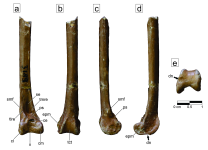Systematic paleontology
Aves Linnaeus, 1758
Anseriformes Wagler, 1831
"
Telmabates” howardae Cracraft, 1970 can be assigned to Anseriformes based on the following characters observed in the tibiotarsus: shaft deeper than wide, sulcus musculus fibularis clearly delimitated by cranial and laterocranial ridges and the proximal part faces cranially,
well developed tuberculi retinaculi extensori, broad incisura intercondylaris, a centrally situated deep sulcus extensorius, with its medial rim smoothly ending into the condylus medialis, and a medially displaced condylus medialis compared with the shaft.
"
Telmabates”
howardae differs from the Late Paleocene stem Anseriformes
Conflicto antarcticus in several aspects. The tibiotarsus of “
Telmabates”
howardae extends more medially, and the sulcus m. fibularis faces less cranially. The pons supratendineus is centrally located regarding the shaft, while it is centrolaterally located in
Conflicto. Additionally, the condylus lateralis of “
Telmabates”
howardae has a nonrounded margin, unlike presbyornithids, and the epicondylus lateralis is strongly
projected, in contrast to
Conflicto where it is not projected. In medial view, the epicondylus medialis of “
Telmabates”
howardae is cranial regarding the cranial border of the shaft, and in cranial aspect, the sulcus extensorius is more laterally placed.
“
T.”
howardae differs from presbyornithids in several aspects. In medial view, the epicondylus medialis of “
T.”
howardae is cranial to the projection of the rim of the shaft, while in
T. antiquus, it is caudal to the projection of the rim of the shaft. Additionally, the canalis extensorius is more lateral in
T. antiquus,
Wilaru, and
Presbyornis. A fundamental difference between “
T.”
howardae and presbyornithids lies in the position of the condylus lateralis. In “
T.”
howardae, its lateral margin aligns with the sulcus m. fibularis, while in presbyornithids, the lateral margin of the condylus lateralis is lateral to the sulcus.
"
Telmabates"
howardae differs from
Telmabates antiquus Howard, 1955 in several aspects. In
T. antiquus, the condylus medialis extends more medially, the pons supratendineus is narrower lateromedially and longer proximodistally, the sulcus extensorius is
proportionally narrower, and the condylus lateralis is more medial and narrower.
Additionally, in
T. antiquus, the insertion of the lig. tibiometatarsale intercondylare exhibits a pronounced ridge bounded by two mediolateral grooves, a feature absent in “
T.”
howardae. The tuberculum retinaculi extensori medialis is oriented more towards
the canalis extensorius, while it is more cranial in “
T.”
howardae. In
T. antiquus, the sulcus m. fibularis is broad and oriented laterodistally, whereas in “
T.”
howardae, it is narrower, more clearly delimited by narrow ridges, and oriented proximodistally before
developing laterally in the distal-most part. Finally, the distal part of the incisura intercondylaris in cranial view is asymmetric in
T. antiquus, (as in Presbyornis and
Wilaru), having a slope to the condylus medialis, while it is symmetrical and shallower in “
T.”
howardae.
“
T.”
howardae differs from Anhimidae and Anseranatidae in several ways. The distal opening of the canalis extensorius in “
T.”
howardae is equidistant between and to both condyles. Additionally, it lacks the prominent tubercle laterodistal to the pons supratendineus reported by Musser and Clarke (2022) for their new anseriform. “
T.”
howardae also differs from the late Oligocene Romainvillidae
Saintandrea chenoides (Mayr and De Pietri 2013) and the crown Anatidae by possessing a proportionally broader, blunt, and less developed condylus medialis. Finally, “
T.”
howardae differs from
Cygnavus senckembergi (early Miocene) (Lambrecht 1931) as its tibiotarsus is proportionally narrower, with condyles more medially located and with a broader pons supratendineus.
Familia
Incertae Sedis
Wunketru gen. nov.
Type species Telmabates howardae Cracraft 1970. Las Flores Formation, early Eocene, Cañadón Hondo locality, Chubut Province, Argentina.
Etymology: From wün, “dawn” and ketru, “duck”, in Mapudungun, the language of the Mapuche people, native from southern Argentina and Chile. The genus is masculine in gender.
Diagnosis: Wunketru is a medium-sized anseriform diagnosed by the following combination of characters: (1) an epicondylus lateralis strongly projected and located in the center of the condylus lateralis, (2) a condylus medialis that widens mediolaterally at its distalmost part, having a subtriangular shape in cranial view, (3) a sulcus m. fibularis that faces cranially in the proximal half, rotating slightly in the distal part, clearly delimited by cranial and laterocranial ridges, (4) sulcus m. fibularis aligned with the lateral margin of the condylus lateralis, (5) a proximodistally broad pons supratendineus with the distal opening of the canalis extensorius ending centrally between the condyles, (6) a depression bounded by marked rims above the condylus lateralis, (7) a shallow and symmetric incisura intercondylaris, and (8) a round distal margin of the condylus lateralis. Characters 4 and 6 are exclusive to the genus.
Wunketru howardae (Cracraft 1970) comb. nov.
Holotype: AMNH 3189, distal end of right tibiotarsus.
Age and locality: Early Eocene, Las Flores Formation, Cañadón Hondo locality, Chubut Province, Argentina.
Diagnosis: As for the genus.
Included species: Only the type species
Fred
Fig 1.
Wunketru howardae (Cracraft 1970) holotype. Right tibiotarsus, AMNH 3189 in a) cranial, b) caudal, c) lateral, d) medial and e) distal view. Abbreviations: ce, canalis extensorius; cl, condylus lateralis; cm, condylus medialis; dn, distal notch; epm,
epicondylus medialis; ii, incisura intercondylaris; ps, pons supratendineus; se, sulcus extensorius; smf, sulcus m. fibularis; tct, trochlea cartilaginis tibialis; tlre, lateral tubereculum retinaculi extensori; tmre, medial tuberculum retinaculi extensori. [Planned for page width]






